Keeping a toilet spotless can often feel like an uphill battle, especially when faced with stubborn stains that seem immune to traditional cleaning methods.
However, with a clear understanding of the different types of toilet stains, their common causes, and their impact on cleanliness, you can better combat these pesky blemishes. Coupling this knowledge with the correct selection of cleaning materials can significantly enhance your cleaning arsenal.
Add to this a few house-tested DIY toilet cleaner hacks and you’re well on your way to maintaining a perpetually pristine porcelain throne.
Welcome on board; let’s dive into these insightful topics and equip you with the knowledge to keep your toilet gleaming all year round.
Understanding Different Toilet Stains
Understanding Common Toilet Stains and Their Causes
When it comes to maintaining a clean and comfortable home for your little cherubs, the humble bathroom can bring to light a surprising number of questions.
Have you ever wondered why you’re battling persistent stains in your loo, despite your best efforts with the toilet brush? We’ve all been there and it can be quite the conundrum.
The first step in effectively dealing with this mystery begins with identifying the type and cause of the toilet stain. Armed with this knowledge, we can then procure the best tools for battling these unwelcome bathroom guests.
Here is a swift and straightforward guide to the types of common toilet stains and their causes.
- Rust Stains: Characterized by their unmistakable reddish-brown hue, rust-stains are causing all of us to wrinkle our noses in dismay. These stains are typically caused by iron in the water. High iron content can come from an iron pipe system, rusting pipes, or even the well water itself.
- Hard Water Stains: Locations with hard water have a high concentration of minerals such as calcium and magnesium. Over time, these minerals build-up, leading to chalky white or yellow stains. Although not harmful, these stubborn stains will require elbow grease and a limescale remover to banish.
- Mold and Mildew: Spotted dark patches around the toilet bowl? Mold and mildew love a damp environment. These stubborn spots may start small but will steadily grow if left untreated. Regular cleaning and good ventilation can help to minimize these types of stains.
- Blue-Green Stains: If your toilet is showing signs of blue-green stains, copper piping might be the culprit. Acidic water conditions can corrode copper plumbing, releasing the copper into the water forming a blue-green stain on toilet and fixtures. Although not harmful, it is a sign of pH imbalance in your water.
Armed with this knowledge, cleaning doesn’t feel quite so daunting.
It’s important to regularly clean your toilet to prevent these stains from settling in and becoming stubborn marks – turning your chore into a labour of love that keeps your family happy and healthy.
Yet, remember, a stain is not a definitive verdict! With the right cleaning tools and a touch of determination, every toilet can shine like the porcelain throne it was meant to be.
Remember, our homes are meant to be lived in and loved, so don’t stress about the occasional toiletry mess. With an understanding of what’s causing the stain, you’re already halfway to a sparkling solution.
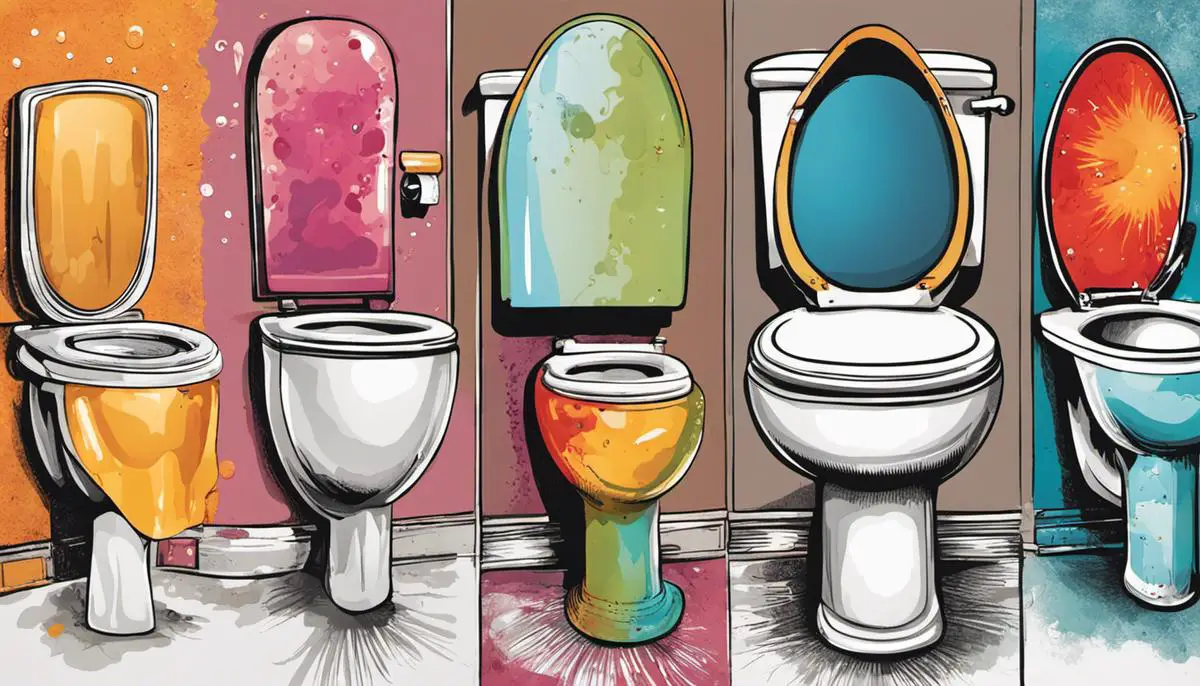
Choosing the Right Cleaning Materials
The Ultimate Guide to Toilet Stain Cleaning
We’ve all been there: tilted head, narrow-eyed stare, and puzzled grimace, trying to decode the unsightly stains tarnishing our shining toilet bowls.
Fear not dear reader, your trusted virtual neighbor is here to lend a helping hand. Today we will discuss the best cleaning materials to tackle various types of toilet stains.
Let’s begin with rust stains. You can easily remember this tip – rust equals iron deposits. For these stubborn stains, the ideal cleaning agents are pumice stones or commercial cleaners specifically designed for iron and rust removal.
Another ingenious remedy you can find in your pantry is a concoction of white vinegar and baking soda. Soak the stains in vinegar, sprinkle some baking soda, and let the fizzy reaction do its magic!
Hard water stains are similar foes. You’ve likely witnessed these as chalky white rings under the waterline – telltale signs of mineral deposits like calcium and magnesium. There are several cleaning solutions you can use here, such as vinegar, baking soda, or even cola. However, a more powerful and effective route is a commercial scale remover. These cleaners are designed to break up the hard mineral deposits and restore your porcelain throne to its former glory.
Then, we have mold and mildew. These fungi thrive in damp environments and can leave unsightly (not to mention unhealthy) black or pink spots. For these nasties, bleach-based cleaners are your best friends. It’s crucial to follow safety precautions and ensure proper ventilation while using these products. Some may prefer a natural route, for which vinegar and tea tree oil can provide an effective solution.
Those mysterious blue-green stains may leave you perplexed, but don’t be intimidated! These are typically a result of copper traces in your water. To banish these, a conventional acidic cleaner, like lemon juice or vinegar, should do the trick. Alternatively, a commercial acidic toilet bowl cleaner should also suffice.
The key thing to remember when dealing with toilet stains is that not all cleaners are created equal. Each stain is unique in its composition, and thus requires a specifically targeted remedy. What works for one stain, might not work for another, so arm yourself with a varied toolkit and a healthy dose of elbow grease!
Last, but not least, an ounce of prevention is worth a pound of cure. Regular, routine cleaning can help keep those hideous stains at bay, ensuring your commode stays clean and welcoming, just like the proud homemakers we strive to be. So, gather your weapons of choice and charge head-first into the battle against toilet stains. Good luck, dear reader, it’s time to claim back your porcelain throne – you’ve got this!
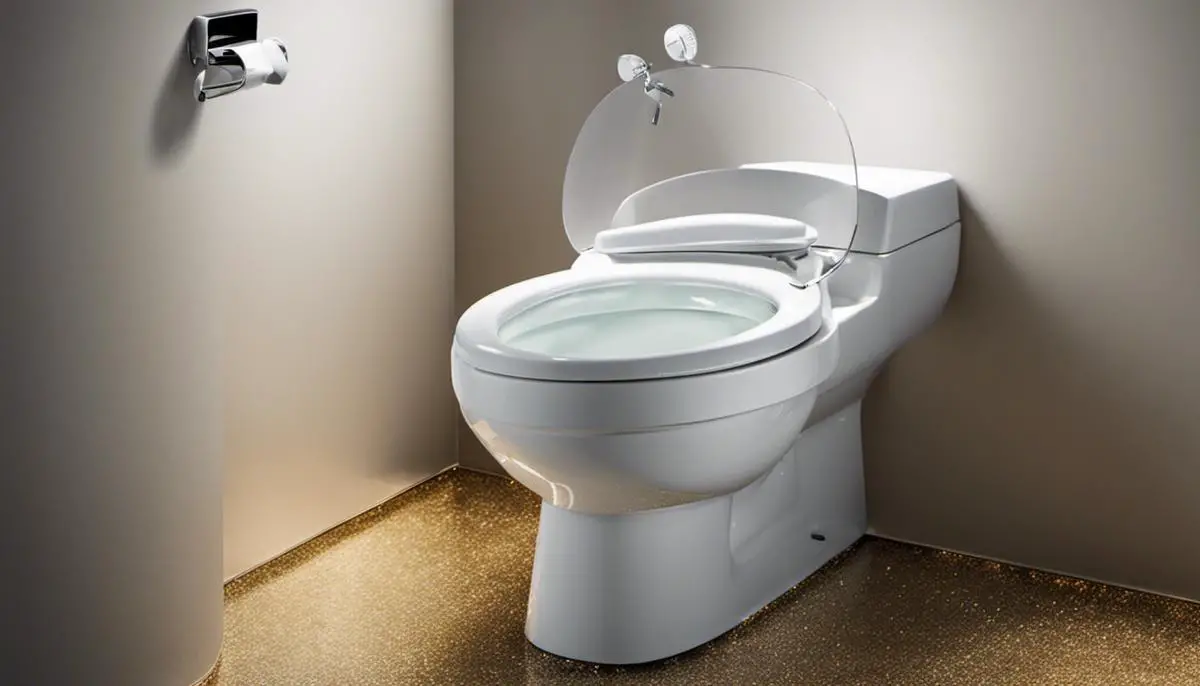
Applying DIY Toilet Cleaner Hacks
Every home deserves a clean, fresh toilet. It’s not just about the physical appearance or pleasant aroma, though. A clean toilet also contributes to the overall health and wellbeing of your family. Let’s dive into some smart, do-it-yourself tips on how you can scrub away those stubborn stains with efficiency.
If rust is the culprit causing toilet blemishes, a dynamic duo of vinegar and baking soda proves quite effective. Begin by applying vinegar to the rust stain and allow it to settle for about 30 minutes. Following this, sprinkle some baking soda over the vinegar. A fizzy reaction immediately gets to work, loosening up rust stains for easy removal.
Hard water stains, often chalky and white in appearance, can be a tad tricky due to the scale build-up. Fear not! You can banish them with – believe it or not – cola. This bubbly beverage, due to its mild acid content, can break down the hard water deposits. Pour a can’s content into the toilet, ensuring to cover all areas with stains. Let it sit for a couple of hours, scrub with a toilet brush, and flush for a sparkling bowl!
When it comes to mold and mildew stains, which pose a potential risk to your family’s health, tea tree oil comes to the rescue. Mix a couple of drops of this antifungal essential oil in a spray bottle of water and apply liberally to the stain. Again, let it sit for about 30 minutes, then scrub and rinse. Not only will your toilet be spotless, but it’s left with a refreshing, natural scent too.
As for blue-green stains that owe their existence to trace copper in the water, lemon juice proves a reliable ally. Generously apply freshly squeezed lemon juice to the stubborn stain, the acidity in the lemon will do work in breaking up the copper deposits. Let it rest for a few minutes, then scrub away with a toilet brush.
Lastly, pumice stones, while a bit unconventional, prove quite useful for all stubborn stain types. Ensure the stone is wet to prevent scratching, then gently rub at the stained surfaces. It seems hard labor, but it will be worth it, promise.
A strong line of defense against any future stain breakouts is regular cleaning. Using vinegar, baking soda, or bleach-based cleaners should do the trick. These substances not only disinfect but also prevent scale buildup and bacterial growth.
Remember, a clean toilet isn’t a luxury; it’s a necessity – contributing not only to a beautiful home but a healthy one, too. Use these simple DIY tips to keep your beloved home bright and shiny, just the way it deserves to be!
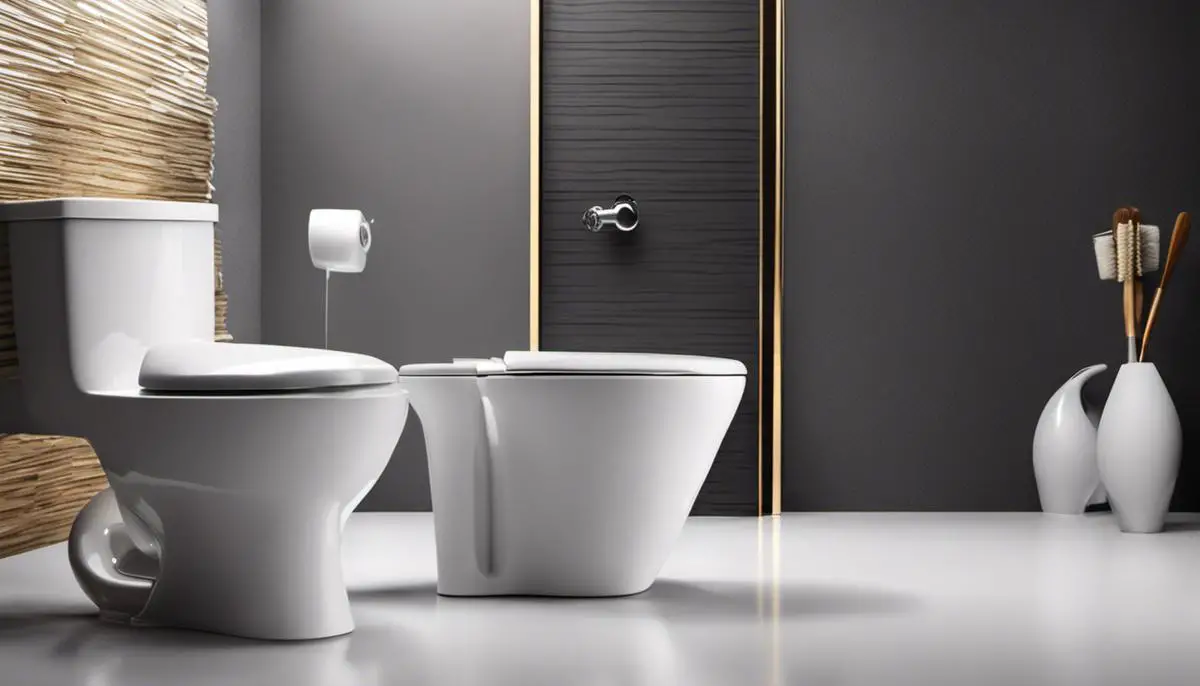
Whether it’s unsightly rusty streaks, relentless limescale deposits, or that dreaded murky ring around the bowl, all toilet stains can be effectively tackled with relevant knowledge and the right cleaning tools. Armed with the understanding of these stains and their common culprits, the discerning selection of appropriate cleaning materials, and the application of tried-and-true DIY toilet cleaning hacks, maintaining a spotless toilet becomes an achievable task rather than an insurmountable challenge. So roll up those sleeves, apply these strategies, and say goodbye to stubborn toilet stains forever!




![How to Remove Crystallized Urine [Explained]](https://homepander.com/wp-content/uploads/2022/02/How-To-Remove-Crystallized-Urine.jpg)
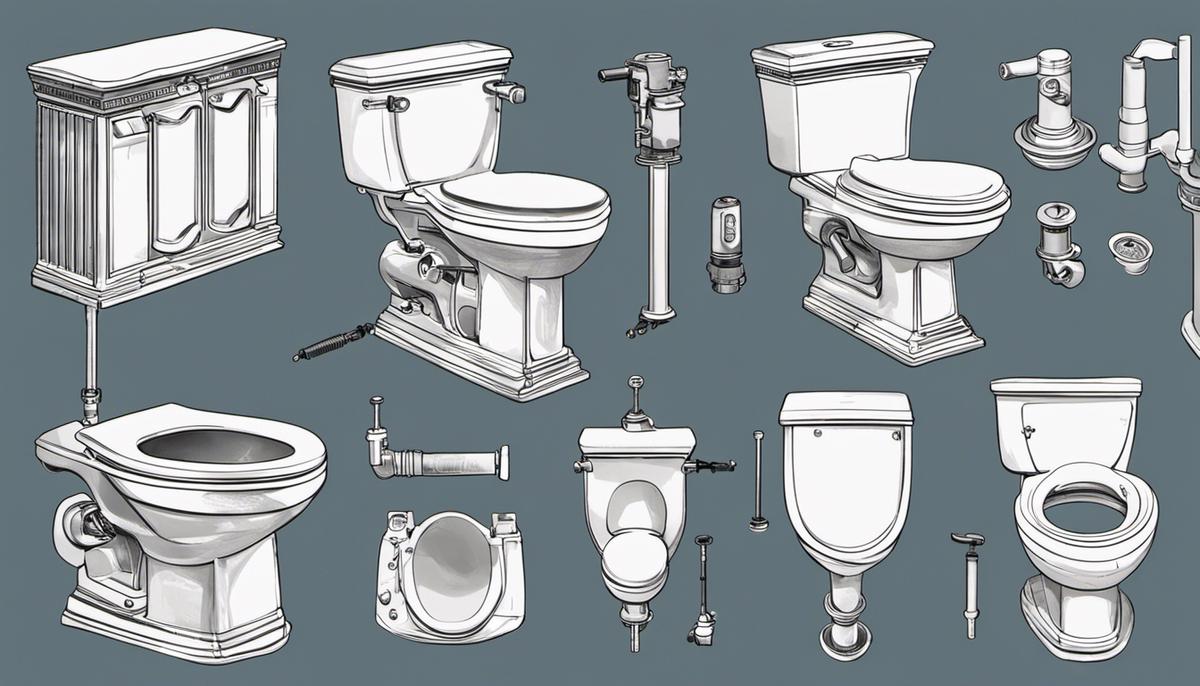
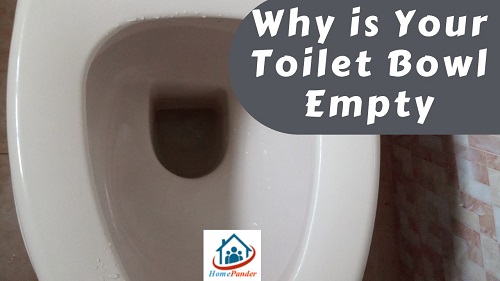
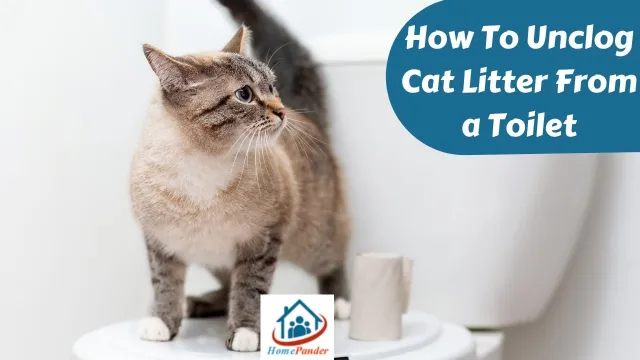
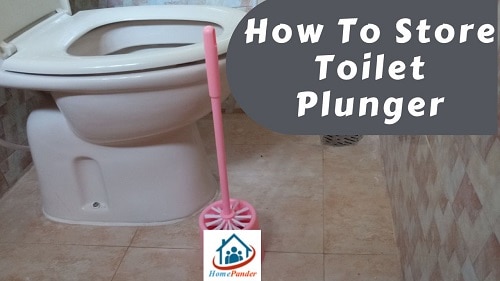
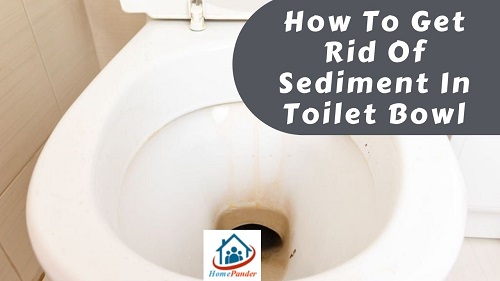
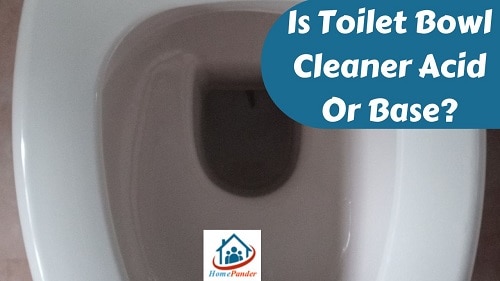
![How To Clean Dark Grout That Has Turned White [5 Easy Ways]](https://homepander.com/wp-content/uploads/2021/12/How-To-Clean-Dark-Grout-That-Has-Turned-White.webp)